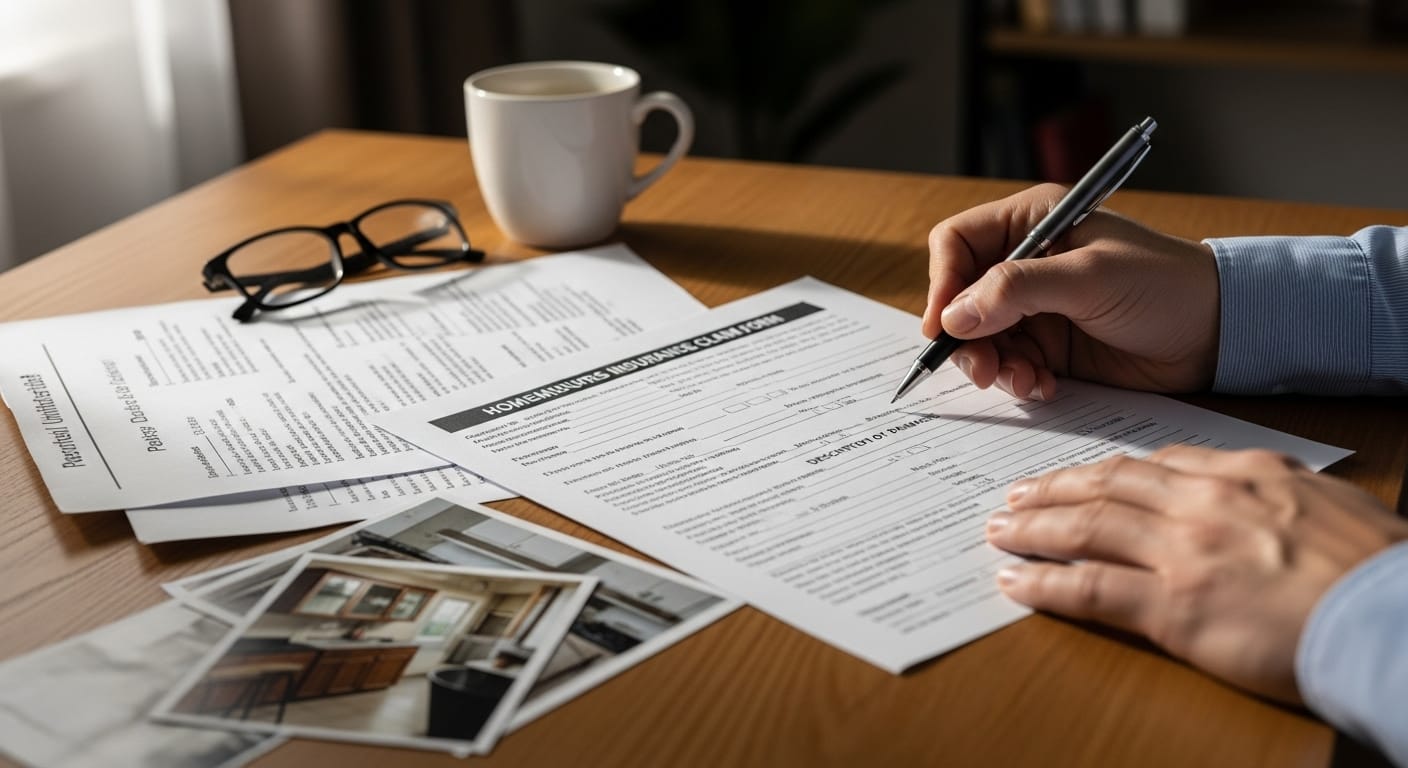Please Note: This post may contain affiliate links. If you click one of them, we may receive a commission at no extra cost to you. As an Amazon Associate, I earn from qualifying purchases.
So, you’ve just experienced some damage to your home—maybe a tree fell on your roof, or that plumbing issue you’ve been ignoring turned into a small indoor pool. Your first thought is, “Great, thank goodness for homeowners insurance!”
But then reality sets in: You now have to navigate the process of filing a claim. And if you’ve never done this before, the whole thing can feel a little like learning how to juggle flaming swords while riding a unicycle. It’s tricky, but totally doable.
Well, don’t fret! I’m here to guide you through the often confusing, sometimes frustrating, but ultimately rewarding process of filing a homeowners insurance claim. So grab a cup of coffee (or something stronger) and let’s dive in.

Top Takeaways and Key Concepts
Review Your Policy: Check coverage and exclusions before filing a claim to avoid surprises.
Document All Damage: Take detailed photos, videos, and lists of damaged property for stronger claims.
Contact Your Insurer Clearly: Provide facts and documentation, and ask about next steps in the process.
Schedule Inspections and Estimates: Coordinate with adjusters and gather multiple repair quotes to ensure fair coverage.
Review and Negotiate Settlement: Compare payout with actual repair costs, and keep receipts for all expenses.
Summary of This Article
The article guides homeowners through filing an insurance claim after property damage. Key steps include reviewing your policy for coverage, documenting damage thoroughly, and clearly communicating with your insurance company. Scheduling inspections and collecting multiple repair estimates ensures accurate claim evaluation. Finally, carefully reviewing the settlement offer and negotiating if necessary helps secure sufficient funds for repairs. Following these steps, along with keeping detailed records, improves the likelihood of a smooth and successful claim process.
Review Your Insurance Policy

Before you get too excited about calling your insurance company and reporting the damage, take a breath and pull out your homeowners insurance policy. Yes, I know, it’s that thick stack of papers you’ve been ignoring since you signed up. Now’s the time to dust it off and actually read it—well, skim through it at least.
By the way, this step is crucial. Why? Because your policy might have exclusions that could leave you stuck without coverage. For instance, does your policy cover water damage from a burst pipe or flooding from a nearby storm? Some policies have these fine print exclusions that could mean you’re out of luck. So, before you start imagining your payout, double-check that your claim is something your policy actually covers.
Document the Damage
Now comes the detective work. You’ve got damage, and you’re ready to file a claim—but before you even think about calling your insurer, you need to document everything. And I’m not talking about just snapping a quick photo with your phone while standing in the rain. No, no. You need to take detailed pictures, video footage, and even make a list of all the damaged property.
Interestingly enough, the more thorough you are, the better your chances of getting the claim approved. So, channel your inner Sherlock Holmes and take as many photos as you can from different angles. Take note of the time, the date, and the condition of the damage before you start cleaning up. Trust me, insurance companies love it when you have all your ducks in a row.
Contact Your Insurance Company
Once you’ve gotten all the evidence together (and probably some extra coffee for stamina), it’s time to contact your insurance company. Honestly, this step could be a little like entering the Twilight Zone. You’ll probably get stuck in an endless loop of automated responses. But don’t give up! Press those buttons, jump through the hoops, and eventually, you’ll get to speak to an actual human.
When you do reach a person, make sure to explain everything clearly. Don’t sugarcoat the situation, but also don’t make it sound worse than it is. Just stick to the facts, tell them what happened, and provide your documentation. And don’t forget to ask them about the next steps in the process. They should walk you through what’s needed on their end and give you an idea of how long things might take.
Schedule an Inspection
After you’ve filed the claim, the next step is often an inspection. This is where things can get a little nerve-wracking, as the insurance adjuster will come to evaluate the damage and determine how much they’re going to pay you. The adjuster’s job is to assess the situation and report back to the insurance company, but here’s the thing: their goal is to minimize the payout.
I know, right? It sounds like the insurance companies are out to get you. But to be fair, the adjuster’s role is more about ensuring that the damage matches the policy coverage and that you’re not trying to pull a fast one. But this is where the evidence you gathered earlier comes in handy—having solid documentation can back up your claims and help the adjuster see things your way.
Get Repair Estimates
Here’s where you get to start working on the actual repairs. While you’re waiting for the insurance adjuster to do their thing, you can start calling contractors to get repair estimates. Don’t just take the first estimate you receive. Get a few different opinions to make sure you’re getting a fair price.
And here’s a pro tip: Keep those estimates handy for when the insurance company sends you their payout offer. You want to make sure that the amount they’re offering covers the actual cost of repairs. If it doesn’t, don’t hesitate to negotiate. After all, you’re trying to restore your home—not fund the insurance company’s next big executive retreat.
Review the Settlement Offer
Once the insurance company has had time to review everything, they’ll send you a settlement offer. This is the point where the rubber meets the road. You’ll need to carefully review the offer to see if it covers the full cost of repairs, your deductible, and any additional expenses. If the offer looks good, great! If not, it’s time to negotiate.
Speaking of which, don’t just take the first offer as final. Insurance companies are notorious for offering less than what you’re actually entitled to. So, if their initial offer isn’t enough to cover all your costs, don’t be afraid to ask for more. You might even need to provide additional documentation, like your contractor’s estimates or a second inspection.
Finalizing the Claim and Repairs
Once you’ve reached an agreement with the insurance company, it’s time to get the repairs done. If you’ve already received the funds, great! Get those contractors on the job and restore your home to its former glory.
If you’re still waiting for the payout, keep in touch with your insurance company to ensure the check arrives as promised. And by the way, it’s always a good idea to keep all receipts for the repairs and any additional expenses. If anything goes wrong or you need to file another claim later, having a complete paper trail will save you a lot of time and stress.
Resources
How to File an Insurance Claim
https://www.iii.org/article/how-to-file-an-insurance-claim
Understanding Homeowners Insurance Claims
https://www.nolo.com/legal-encyclopedia/homeowners-insurance-claims.html
Tips for Filing a Homeowners Insurance Claim
https://www.consumerreports.org/homeowners-insurance/tips-for-filing-a-homeowners-insurance-claim/
Frequently Asked Questions
What should I do first when filing a homeowners insurance claim?
Start by reviewing your insurance policy to confirm the damage is covered and understand any exclusions or deductibles before notifying your insurer.
How should I document property damage for my claim?
Take clear photos and videos from multiple angles, make a detailed list of damaged items, and record dates and times before beginning cleanup.
When should I contact my insurance company after damage occurs?
Contact your insurer as soon as possible after the damage, providing all documentation and asking about the next steps in the claim process.
What happens during the insurance inspection?
An insurance adjuster will visit your property to assess the damage, review your documentation, and determine the amount the insurer will cover.
Why should I get multiple repair estimates?
Obtaining several estimates helps ensure fair pricing and gives you leverage if your insurer’s payout offer is lower than actual repair costs.
Can I negotiate the insurance company’s settlement offer?
Yes, if the offer doesn’t cover all repair costs, you can negotiate by providing contractor estimates or requesting a reinspection to support your claim.
What records should I keep after filing a claim?
Keep copies of your claim documents, adjuster reports, repair receipts, and all communication with your insurer for future reference or disputes.

Kevin Collier is a legal expert passionate about simplifying complex legal concepts for everyday individuals. With a focus on providing clear, practical information, he covers a wide range of topics, including rights, responsibilities, and legal procedures. Kevin aims to empower readers with the knowledge they need to navigate the legal landscape confidently, ensuring they can make informed decisions regarding their legal matters. Through insightful articles and easy-to-understand resources, he helps demystify the law, making it accessible to all.










